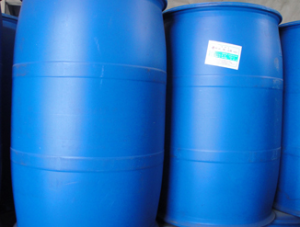Molecular formula: CH2(COOC2H5)2
Molecular weight: 160.17
CAS: 105-53-3
1. Properties:
Colorless liquid with slight aromatic odor; Melting point: -50°C; Boiling point:198 ~ 199°C(95°C/2.67kPa); Density:1.055~1.056; Refractive index: 1.4143; Slightly soluble in water; Soluble in ethanol, ethyl ether, chloroform and benzene; The hydrolysis products of diethyl malonate under the acid or alkali condition are malonic acid and ethanol.
2. Specification:
|
properties
|
specification |
|
|
Appearance |
Colorless, clear liquid |
|
|
Colour Index (Hazen) |
≤15 |
|
|
Density |
1.055-1.058 |
|
|
Refractive Index |
1.413-1.415 |
|
|
Content Fe |
≤4ppm |
|
|
Content Diethyl Malonate (by GC) |
≥99.2% |
|
|
Content Ethanol (by GC) |
≤0.5% |
|
|
Content acid |
as Malonic Acid |
≤0.2% |
|
as Acetic Acid |
≤0.1% |
|
|
Moisture(H2O) |
≤0.1% |
|
|
Content Benzene |
≤10ppm |
|
|
Chloride |
≤1.0% |
|
3. Use:
Diethyl malonate is mainly used in the fine organic synthesis and for the preparation of mono-substituted and di-substituted acetic acid. In the pharmaceutical industry, diethyl malonate is used for the synthesis of pharmaceuticals such as chloroquine, butazolidin, barbital and so on. Besides, it also can be used in industries of pesticide, paint, spice and so forth.
4. Packaging & Storage:
200L plastic drum, 200Kg per drum.
Use high density polypropylene barrel for packing. Attention please, the package should be sealed to prevent moisture intrusion.
| 5. Frequently Asked Questions Q: Spill emergency treatment?  A: Quickly evacuate the personnel in the leaked contaminated area to a safe area, and isolate them, strictly restricting access. Cut off the fire source. It is recommended that emergency personnel wear self-contained positive pressure breathing apparatus and wear protective clothing. Cut off the source of the leak as much as possible. Prevent flowing into restricted spaces such as sewers and flood drains. Small spills: Absorb with sand, vermiculite or other inert material. It can also be brushed with an emulsion made of a non-flammable dispersant, and the lotion is diluted and put into the wastewater system. Large amount of leakage: Construct dikes or dig pits for containment. Use a pump to transfer it to a tank truck or a special collector, and recycle it or transport it to a waste treatment site for disposal. Q: First-aid? A: Skin contact: Take off contaminated clothing, rinse with running water. Eye contact: Lift the eyelids and rinse with running water or saline. Seek medical attention. Inhalation: Get away from the scene to fresh air. If breathing is difficult, give oxygen. Seek medical attention. Ingestion: Drink plenty of warm water, induce vomiting. Seek medical attention. |
